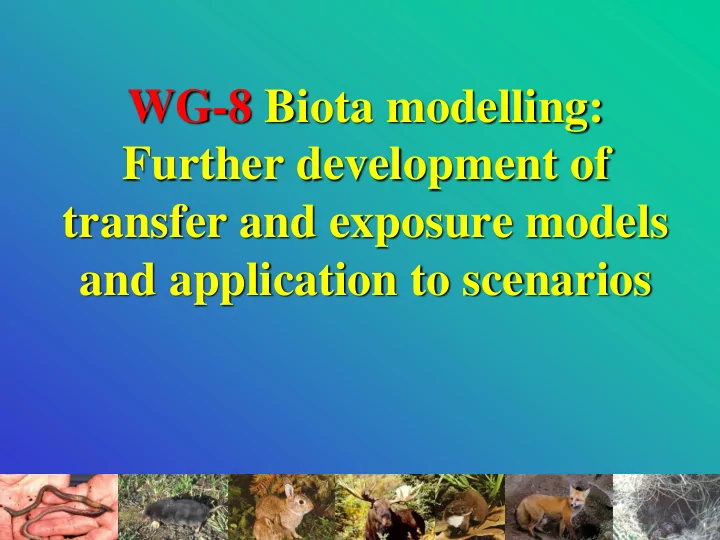

WG-8 Biota modelling: Further development of transfer and exposure models and application to scenarios
Activities agreed Nov. 2012 • Modelling exposure in spatially heterogeneous environments • Simple whole- organism ellipsoid geometries v’s Voxel phantoms • Develop scenario for Fukushima marine environment • Collate biological half-life data for wildlife • Guidance documentations .... Lessons learnt EMRAS I & II
Modelling spatially heterogeneous environments • WHY: Typically simplistic Estimating soil contamination in – Point of capture media home ranges of different species concentrations – Average over likely home- range • Is that good enough?
Modelling spatially heterogeneous environments • Review of approaches used in other fields • Presentation of potential datasets for modelling • Aim: Select scenario(s) to be modelled over the next year(s) Photos: Sergey Gashchack (Chornobyl Center)
Dosimetry • WHY: Whole-organism dose rates estimated assuming homogenous (ellipsoid) geometry
Dosimetry
Dosimetry • Are simple models sufficient? Liz Ruedig Colorado State
Dosimetry Why: Activity concentrations measured/predicted without GIT - Should we ignore dose (& foodchain transfer) from GIT contents? Mat Johansen (ANSTO)
Dynamic models • WHY: Assume equilibrium – Some criticism – Is it conservative? – Not suitable for modelling accidental releases
Fukushima scenario • Water & sediment inputs supplied by WG10 (predictions to end July 2011) – Cs-137, Sr-90, I-131 • Results submitted by 7 modellers – Including one set from ERICA (equilibrium) for comparison • Methods to be presented & discussed – Provisional comparison
Biological half-lives for wildlife • Species/ecosystems divided amongst participants (Nov 2012) • Spreadsheet to record data supplied • Preliminary reports in May 2013 – update this meeting
Guidance documentation • Suggested by a number of participants: – On basis of what learnt from EMRAS etc. provide guidance on wildlife assessments (e.g. coping with missing data, considering decay series, are some models better for certain elements of assessment than others, are dose rate benchmarks fit for purpose) Sub-group to meet before the main group to focus this activity
Publications MP Johansen, E Ruedig, NA Beresford, K Tagami, S Uchida. Sequestration of 137 Cs in marine fish tissues and organ-specific dose modelling: data review and recommendation for future sampling (Sub: IAEA ‘Fukushima’ meeting 2014) Submitted to Barcelona conference: MD Wood, NA Beresford, C Bradshaw, S Gaschak . Advances in environmental radiation protection: re-thinking animal- environment interaction modelling for wildlife dose assessment NA Beresford, J Vives i Batlle, M Johansen, R Goulet, K Beaugelin-Seiller, P Andersson , K Stark, E. Ruedig, MD Wood, S Fesenko. Modelling the exposure of wildlife to radiation: key findings and activities of IAEA working groups
Outline agenda • Wednesday morning after plenary: sub- group only to meet to discuss ‘guidance documentation’ – P. Andersson, K. Beaugelin-Seiller, N.A. Beresford, D. Copplestone, M. Johansen, K. Stark, H. Vandenhove, M. Wood, T. Yankovich • Wednesday 13:30 onwards – Fukushima scenario (with WG10) – Biological T1/2 review (inc. C & OBT modelling)
Outline agenda -Thursday – Comparing Voxel phantoms with homogenous assumptions – Dose from GIT (marine fish) – Effect of soil moisture on DCCs – Overview of methods used for ‘spatial exposure’ – Presentation & selection of potential spatial datasets (inc some planned studies) – Biological T1/2 review - complete if not finished Wednesday (will be afternoon) – Updates
Recommend
More recommend